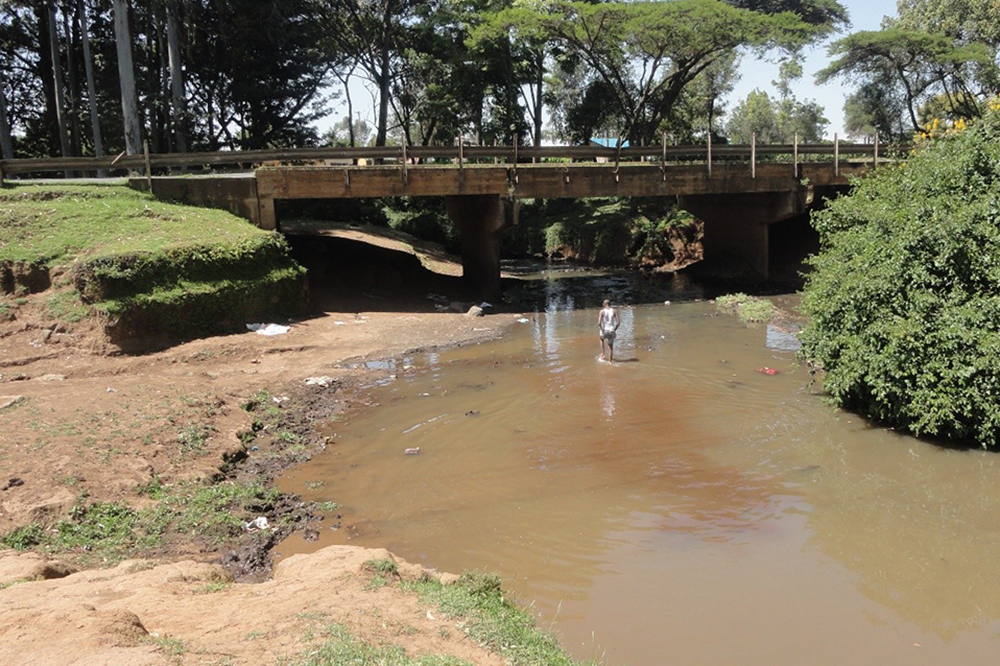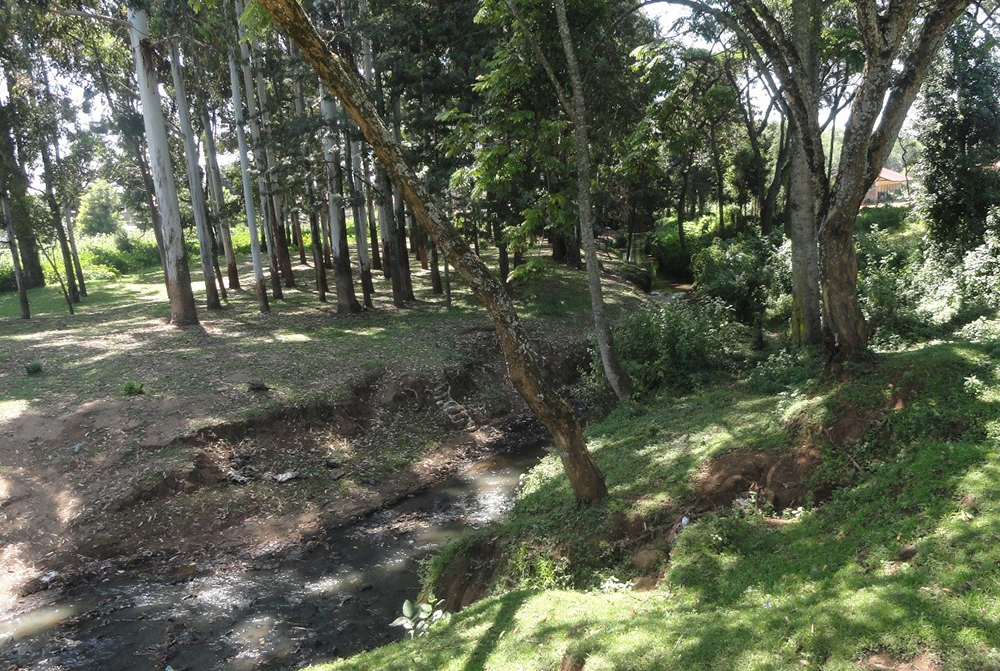
A man walks in the Murungato River in search of sand. The Kalondon River splits from the Murungato River toward Mathari. (Courtesy of Shadrack Omuka)
The impacts of climate change and intense human activity threaten a river owned by a Catholic archdiocese in Kenya. Through better informing local communities and farmers about what causes the river to dry up and become polluted, the Catholic Archdiocese of Nyeri hopes to aid in protecting the Kalondon River and its surrounding land.
Made in 1902 by Consolata Missionaries who had settled in Mathari, the small river in Kenya has been flowing ever since. The missionaries needed water for their domestic use and to generate electricity for a missionary hospital and school, so they were given the land by the colonial government. When the missionaries left the country, the Archdiocese of Nyeri started the process to formalize its ownership by acquiring a title deed for the river and the land it passes through.
The aim of ownership was to serve as a means of conserving the water and land and assuring its continued existence in the future. According to church management, the river has been of great benefit to the church, schools and surrounding communities, but they say some locals disagree with them about how the river should be used.
Recently, the river has been facing numerous challenges, including logging upstream, waste dumping from locals and illegal tapping. Farming activities near the river lead to soil erosion, siltation, illegal irrigation and the dumping of toxic chemicals. Some farmers along the river are using four-inch diameter pipes for irrigation, which goes against the irrigation act in Kenya.
Advertisement
Archbishop Anthony Muheria of the Nyeri Archdiocese has been at the forefront of pleading with locals to protect the river by shunning illegal dumping and problematic methods of farming around bodies of water.
The bishop expressed concern over the damage of forests and the dumping of solid and liquid waste not only in the Kalondon River, but also other water sources in the country, which he said spells doom in the future.
"People must take care of water sources not only in Kalondon, but all water sources, and practice sustainable use of water if they expect to continue benefiting," he told EarthBeat.
The Kalondon River splits from the Murungato River toward Mathari. It gets its water from the Aberdare Ranges, among the largest of Kenya's water towers. The river flows to Nyarungumu, a densely populated village in Nyeri County in the central Kenya region, covering two acres before returning to its source through Nyeri Hill Farm, which is also owned by the archdiocese.

The water level of the Kalondon River in Nyeri, Kenya, has decreased due to logging upstream, encroachment, non-native plants nearby, unsustainable irrigation use and other climate impacts. (Courtesy of Shadrack Omuka)
According to Nyeri-based priest Fr. John Githinji, parishioners in collaboration with surrounding communities occasionally conduct cleaning that protects river banks from erosion, but illegal tapping and tilling of the land that comprises the banks remains a threat to this vital ecosystem.
"We usually do some cleaning once in a while and reforestation along the banks to protect the river, but unfriendly activities continue. As a church we cannot take somebody to court to protect the river, but we will continue doing what we've been advised to do by our leaders," he told Earthbeat in Nyeri.
Another threat to the river is the growing of eucalyptus trees along the banks by farmers who try to sell the trees for timber. Experts say they require a lot of water and contribute to the decreasing water level. In other countries, the government has banned eucalyptus trees along river banks. Some even cut the trees down without informing the owners.
Activities such as bathing, doing laundry and sand harvesting also have been identified as threats to the river's health, according to Githinji. These are small things that can be controlled if communities are better informed on the issues.
The church has been educating locals on the importance of sustainable river use that serves community needs without causing damage to the source. They are trying to raise this awareness not just in churches, but also in the surrounding villages and with local farmers by showing them more effective ways to use water from the river without negatively impacting it.

Eucalyptus trees, a species that is not native to the area and that requires much water, have been planted along the banks of the Kalondan River and contribute to its decreasing water levels. (Courtesy of Shadrack Omuka)
Though some community members have organized themselves into small groups to support conservation measures along the river, Githinji said the awareness they've been raising to save the river needs more support from the community, non-governmental organizations and the government.
Elias Waweru, a Kikuyu community elder in Nyarungumu village who has been at the forefront of spreading awareness against illegal dumping in the river, said that they are working hard to curb illegal activities along the river, but sometimes things go beyond their powers.
"Some farmers along the river are not ready to listen to us and they just do things deliberately knowing that we've nowhere to take them" to hold them accountable, said Waweru.
Waweru said the river serves over 100,000 households but only a fraction of them understand the importance of river conservation. He and other locals have planted more than 5,000 Indigenous trees along the river, but the majority of the trees they have planted have disappeared due to overgrazing and encroachment.
In the Aberdare Ranges, the Kalodon River's source, logging and encroachment is getting intense, which along with climate change impacts, like prolonged droughts, also decreases the river's water level.

Women wash laundry along the bank of the Kalondon River in Nyeri County, Kenya. The river is threatened by unsustainable use and climate change. (Courtesy of Shadrack Omuka)
Reuben Maina, an environmental activist in Nyeri County, said if something isn't done soon, the river might vanish. He expressed concern about lifting a ban on logging in the country, saying that the move will worsen climate vagaries.
"We're already experiencing a climate crisis in this country and I am very saddened by the government move to lift the ban on logging. A river like this one will not survive. It is already struggling due to massive logging upstream," said Maina.
He noted that there used to be creatures in the river, which was a sign of clean water. But nowadays there are none because the water has been polluted, making it difficult for any organism to survive.
Judith Mwangi, a farmer along the river, cautioned all those using banned pipe sizes and cultivating their land up to the river banks to stop.
"If the communities and farmers would like to continue benefiting from the river, then everybody must take responsibility to protect it and practice sustainable use of its water," said Mwangi.




